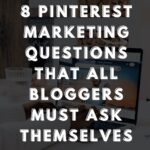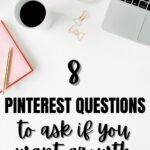This post may contain affiliate links, which means I'll get a commission if you decide to purchase through my links, at NO extra cost to you. Please read my disclosure for more info.
Last updated on February 11th, 2025
When it comes to
While these are valid, they’re not the questions that truly move the needle.
In this post, I’m going to dive into 8 often-overlooked
Let’s jump in.
1. How Many Days in a Row Can I Pin?
The single most common
I challenge you to reframe the question to – how many pins can I pin per day CONSISTENTLY?
Below is a screenshot of
This meant that I was pinning almost every day, even if it was just 1 pin.

It’s better to pin one pin a day (or even once a week—whatever works for you) consistently than to pin 20 pins on one day and nothing for the rest of the month.
Consistency builds trust—not just with
2. Am I Targeting the Right People With My Copy and Keywords?
It’s not just about appearing in search but about appearing in the right search results.
Think about your ideal audience:
- What problems are they trying to solve?
- What exact phrases might they type into
Pinterest search? - What products or inspiration are they looking for?
Keywords are the bread and butter of a successful
For a deeper dive into finding your keywords (for free), check out this keyword guide.
Now, let’s talk about your pin copy.
While I’m no expert copywriter (as most aspiring creators and bloggers are), I’ve picked up a few tricks to improve my pin titles and descriptions:
- Study what’s ranking: Look at the emotional and catchy words that are already performing well in your niche.
Eg. In the chicken noodle soup search below, some of the words pinners used a lot are – homemade, easy, creamy, and old-fashioned. I could use some of these exact words or synonyms like simple 4 step guide or DIY.

- Learn from YouTube titles: I binge-watch a lot of YouTube, and I’ve noticed certain titles always make me click on a video. I try to use those as inspiration for my pin titles.
- Avoid using generic copy: tailor your pins to a specific audience. Think about who your content is meant to help and speak directly to them.
For example, if I were promoting an iPhone photography course I recently signed up for, I could target different groups like:- “iPhone Photography Course for Travel Bloggers“
- “iPhone Photography Course for Better YouTube Videos“
By narrowing your focus, you’re more likely to attract users who genuinely need your content, increasing both your clicks and engagement.
Focus on keywords and copy that resonate with your ideal audience, ensuring your content shows up in the right search results and speaks directly to your target users.
3. Are My Images Stopping the Scroll?
With attention spans shrinking by the second, it’s harder than ever to grab someone’s attention online. Think about how quickly you scroll through TikTok or Instagram—what does it take to stop your thumb?
Now, apply that same logic to
Here are a few questions to explore:
- Are my fonts bold and easy to read, especially on mobile?
- Am I using high-quality images or eye-catching illustrations?
- Do my headlines spark curiosity?
- Am I incorporating videos or animations to stand out in a sea of static pins?
Experimentation is key. For every blog post I write, I try different formats, colors, and styles—including video and animated pins—to see what resonates most with my audience.
Your pins need to grab attention instantly. Use bold fonts, high-quality visuals, and curiosity-driven headlines to stand out, and experiment with different formats to find what works best.
4. Do I Have a System in Place That Makes Consistency Easier?
I’ll admit that consistency is my biggest problem when it comes to content creation. I’ve burnt out several times, getting caught up in the content hamster wheel because I didn’t have a solid system in place.
But over time, I’ve found a few strategies that made consistency easier.
- Using a scheduler: I use Tailwind to queue up pins weeks in advance, so I don’t have to worry about scheduling pins every 30 days if I use the native
Pinterest scheduler. - Batch-creating content: Every 2-3 months, I dedicate about a week to creating 100-150 pins in bulk. This way, I don’t have to worry about making pins every week.
- Keeping a Notion system: I organize everything in Notion—my keywords, schedules for refreshing pins, and even old pin titles and descriptions. Having everything in one place means I can reuse and tweak content quickly when needed.
- Reusing Canva templates: I reuse Canva pin templates to avoid starting from scratch every time. If you’re not a graphic designer like me, you can find pre-made templates on Etsy or use Canva’s template library.
Having a system in place can save alot of time, especially during busy weeks. If consistency feels like a struggle, try one of these strategies to simplify your workflow, and let me know if it helps.
Have systems and workflows in place to make your strategy more manageable and less stressful.
If you’re interested in checking out how I built my
5. Am I adjusting my strategy along the way?
If you have a
One way I use my analytics is to identify which pin designs are getting the most traction. Once I know what’s performing well, I double down on those designs in Canva to create similar content.

It’s not effective to spend your time on strategies or designs that aren’t working. So, the next time you’re on
If you’d like to know which numbers you need to focus on, check out my guide on 5 Pinterest metrics you should pay attention to.
Use your analytics to identify what’s working and focus on doubling down on successful designs, while cutting back on strategies that aren’t delivering results.
6. Am I Using the Most Relevant Boards and Not the Most Boards?
More boards don’t always mean more reach. In fact, having too many boards can dilute your pin’s visibility and make it harder to connect with the right audience because it affects how Pinterest indexes your content.
Each blog post I create pins for is added to a maximum of 3-4 boards—even though
When deciding which board to pin to, I ask myself: What are the top 3 boards that would best reach the right people for this content?
Quick Tip: A simple way to check if a board is relevant to your content is to look at the “more ideas”

Pin to 3-4 highly relevant boards instead of spreading your pins thin across many boards.
Use
7. Is My Profile Optimized to Attract Followers?
Whenever I visit someone’s social media profile—whether it’s
Your
Here’s a quick profile audit checklist to make sure your profile is working for you:
- Is my bio clear about my target audience or who I serve?
- Is my bio keyword-rich? Keywords in your bio are searchable, so use terms your ideal audience might type in.
- Are my boards organized and relevant to my audience’s pain points?
- Do my board covers and banner photos align cohesively with my brand?
An engaging and cohesively aesthetic profile establishes trust as a brand and encourages your audience to see you as a go-to resource worth following.
Use a clear, keyword-rich bio and cohesive board organization to build trust and encourage your audience to see you as a valuable resource worth following.
8. Are Monthly Views the Best Way to Measure My Progress?
The short, painful answer is no.
Monthly views are a nice vanity metric—much like Instagram follower counts—but they don’t tell you much about meaningful engagement with your content. They’re also highly seasonal, fluctuating depending on trends and holidays.
If you’re skeptical, check out this video where a
Instead of obsessing over monthly views, ask yourself: Which metric actually matters most to me?
For most creators, including myself, outbound clicks are the best metric to follow. This metric shows how many people are clicking from your pins to your website, products, or YouTube videos—the actions that can truly impact your revenue for a business.
While monthly views can give you a general sense of reach, they shouldn’t be your primary focus. Prioritize metrics that directly align with your objectives and drive meaningful results for your business.
Conclusion
While it’s normal to worry about how many pins you’re posting or keeping an eye on monthly views, it’s more important to focus on the foundational questions that drive real, sustainable growth.
These are the questions I revisit whenever I get too caught up in the numbers and lose focus on the content quality.
I hope this post has helped you spot any areas in your
Let me know in the comments below which question resonated with you the most or what you’ll be focusing on next.
RELATED: How to keep






